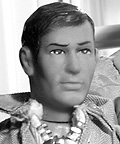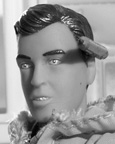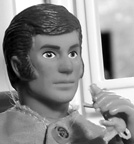 |
|
|
For as long as there have been children
on their backs outside at night, there have been Space Toys. The history of toys in space is an adventure dipped in a conundrum and sprinkled with jimmies of confusion. From humble and dangerous beginnings came shocking defeats and profound discoveries, leading to the mighty sprawl of toys in space that we know today. Looking back, it all seemed so very simple and straightforward.
Astro-Joe's landmark successes in space
were later debunked (see A
Nation Shrieks: Great Marketing Lies Uncovered) when in-depth photographic analysis revealed
that images allegedly showing Astro-Joe in space, being heroic,
were actually taken at a secret media stage in New Jersey. This
revelation, however, failed to tarnish the spirit of adventure
inspired by that pioneering toy and his space-like aura. Although
considered now to be a pox on the action figure world by many
(see Mid-Life Psychotic
Episodes: Astro-Joe and the Death of Masculinity), we must historically nod at the exponential
growth of toys in space since the lift-off of Astro-Joe's enormously
popular artificial career. The modern age of articulated toys in space took root in the early 1970s, when toys with space-going themes were popular but, like Astro-Joe, they existed exclusively in the frigid vacuum of marketing, not space. While many top selling toys were fashioned after popular space-faring characters, none of them had reached any closer to the stars than the average Barbie tossed into a tree by an evil brother. But in the early 70's a group of brilliant
young researchers and curious citizenry began to explore the
possibility of actually sending toys into space, and a great
age of plastic adventure was born. The first step to the stars seemed obvious enough to everyone; the Roof. Attempts to access the roofisphere via an indoor tunnel or passage had consistently failed and many believed the Inside Passage to the Roof to be a myth. But space seemed hungry for launch, and plans developed to send a toy to the roof via some yet undetermined outdoor physical conveyance. Also, by unanimous vote of the early planners, it was determined that this journey would begin with a descending count from a number, possibly 10, and climax in a broad proclamation of success like, "Liftoff!" or "We are GO!". Even with this degree of careful planning, early attempts to reach the roof were marbled with disaster. The development team of upstart science
and math geeks who were to eventually unlock the riddle of toy
space met each other by chance one day at a swap meet and immediately
formed a bond around their shared obsession to someday play among
the stars. The Roof Team (sometimes referred to as Roof-o-nauts) consisted of (below, L-R) Algernon Haley, a gifted young robotics innovator, Edvard Ng, the youngest 3-time graduate of Toy Tech, and Quentin Mertz, a small businessman with dubious connections and a powerful thirst for adventure. This motley team conceived the first most daring attempts to reach the roofisphere.  .
.  . .  Project Ladder
Project Hydro-Lift was the next innovative scheme, which involved water pressure provided by an outdoor hose and a cone shaped hydro-sled that, according to plans, would send the pilot up to the roofisphere with a very wet and ungraceful landing. He was to make a parachute return. Two attempts resulted in as many broken limbs, and the plan was scrapped. Project Slingshot to the Roof Project Off-the-Shed to the Roof combined the finite velocity of the slingshot
with an angled trampoline installed on the roof of a nearby shed
to ricochet into the roofisphere. The below drawing illustrates
the basic concept of this ill-conceived plan. Worse than previous
attempts, this project ended in tragedy when a brave test pilot
was shattered on the wall just above the launch pad, raining
his parts down on the Launch Team. Project Catapult to the Roof was a massive and expensive undertaking involving
sufficient VTP provided by a powerful custom catapult, and was
to be the last attempt to hurl a toy from the ground to the roof.
There was a mysterious lack of qualified test pilots when it
came time to launch, inspiring Quentin Mertz to volunteer in
a fit of pride. A tragic preflight accident, however, simultaneously
disassembled Mertz and shot his parts over the back fence and
into a territory known to be frequented by hostile dogs. Haley and Ng were forced to halt experiments after Mertz's death and all records and photos of Project Catapult were ordered destroyed by the Ministry of Putting a Foot Down (MPFD). As the best and brightest minds reconsidered their equations they discovered that Mertz and the other brave test pilots never would have reached the roof anyway as there had been a critical error in mathematics. The team had neglected to account for the space between the ceiling of the top floor and the surface of roof, the space often called the attic. Project Roof-Or-Bust went completely bust in the mid-1970s. But ironically, what appeared to be the critical weakness in their previous plans eventually became the solution to the challenge of getting toys into space. Many years after Mertz's death the possibility of that solution came to Dr. Edvard Ng as he napped in his hammock.
Within the week a scientific party was
organized and special visas were obtained from the local rodent
authority (see Uneasy
Agreements: The Complicated Sting of Truce)
. After just two weeks of searching, Edvard Ng's epiphany of
possibility was realized when a direct portal into deep space
was discovered in the attic, behind some insulation, next to
a beam. The first organized mission into this vast new toy space was as primitive as it was daring. The best and brightest scientists and technicians again set to work to built the first space module using a #10 can as a chassis and outfitted it with a hodgepodge of borrowed equipment. Christened Trinket 1, her first mission was flown by dedicated test pilot Col. Dan Bowman who was selected for his sturdy constitution, educated determination, and because the suit happened to fit him. The log of Col. Bowman's first orbital
mission, 1,000 Days in a Tin Can, Literally is still required
reading at the Smallonaut Space Academy (SSA). The experimental
Bubble Helmet he wore, designed by Prof. Algernon Haley, proved
to be an effective protective device against the ravages of space
and similar devices are still used today by the many Smallonauts
who followed Col. Bowman into that space. His historic first
words radioed from the other side, "...oh my gosh, it's
full of toys!" may have been scripted back on Earth,
but it inspired a generation of playthings to reach for the stars. After Col. Bowman's groundbreaking mission proved that action figures could play among the stars there was a great expansion of toys into space. The first exploratory missions into what was quickly becoming known as Small Space were organized by the newly created Articulated Space Administration (see ASA). These early teams were dubbed the "Drop Corps" because their missions often involved a free-fall decent into uncharted alien landscapes, and they set a distinguished tone of bravery for all Smallonauts. The Articulated Space Administration
remains the bureaucratic umbilical connecting all space-faring
toys to home. The ASA was established as a regulatory body to
oversee the new "space rush", with authority over travel
and security for all adventurous playthings in space. The Smallonaut
Space Academy (SSA) is the educational arm of the ASA and serves
as a hub for wee explorers interested in this vast new frontier.
The ASA maintains bases on Earth as well as in space, and their
diplomatic officials represent earthly toys in various interstellar
organizations. The fabled Inside Passage to the Roof was
later discovered accidentally by a group of spelunkers ascending
a bathroom vent shaft. They reported that the Roof was sloped
and had a scalelike surface, but other than the view it was pretty
dull up there, and messy. A plaque bearing the names of the brave
test pilots who died trying to reach the roofisphere was glued
to the surface there during the only return trip to that once
elusive region. |
|
|











 (Excerpt from STV documentary
Ng: Omni-Brain)
(Excerpt from STV documentary
Ng: Omni-Brain)
